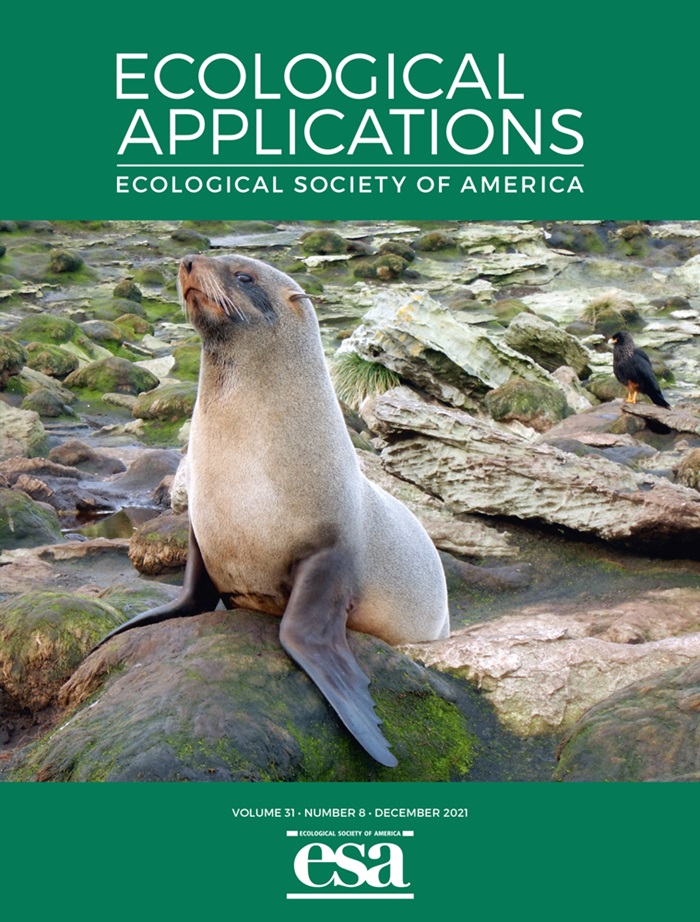量化全球生态系统面对植物入侵的脆弱性
IF 4.3
2区 环境科学与生态学
Q1 ECOLOGY
引用次数: 0
摘要
入侵生态学中被广泛引用的 "十分之一规则 "表明,约有 10%的既有非本地物种会成为入侵物种。然而,由于最初的分析主要集中在英国和澳大利亚的一小部分植物物种上,这一估计的准确性受到了质疑。我们利用一个包含 9501 种既有植物和 2924 种入侵植物的新型数据库,对 "十倍规则 "进行了全面评估,并首次对入侵率在不同空间尺度、岛屿/大陆和气候区之间的差异进行了实证分析。我们发现,入侵率(具有负面影响的既定物种的百分比)在全球范围内存在很大差异。取样良好的环境(至少记录了 2000 种非本地物种)的入侵率从 7.2% 到 33.8% 不等。入侵率与尺度密切相关,在国家尺度上平均为 17%,在大陆尺度上平均为 25%。我们发现,无论规模大小,岛屿的入侵率都明显高于大陆。热带生态系统通常被认为具有抵御入侵的能力;然而,我们的研究结果表明,热带岛屿和陆地的入侵率都显著较高,这表明这些物种丰富的生态系统具有意想不到的高度脆弱性。我们得出的结论是,对植物入侵率的一般估计,"十 "法则并不准确,因为计算出的入侵率差异很大,而且经常远高于 10%。大多数地方最好使用根据接受环境而变化的入侵率。我们对入侵率的最新估计应与入侵物种管理战略高度相关,包括杂草风险评估,在入侵率较高的地区,可以调整评估结果,将更多物种确定为高风险物种。假设 10% 的已确定物种会成为入侵物种,可能会大大低估大多数地区的入侵率。本文章由计算机程序翻译,如有差异,请以英文原文为准。
Quantifying vulnerability to plant invasion across global ecosystems
The widely referenced “tens rule” in invasion ecology suggests that approximately 10% of established, non‐native species will become invasive. However, the accuracy of this estimate has been questioned, as the original analysis focused on small groups of plant species in Great Britain and Australia. Using a novel database of 9501 established plants and 2924 invasive plants, we provide a comprehensive evaluation of the tens rule and the first empirical analysis of how invasion rates vary across spatial scales, islands/mainlands, and climate zones. We found that invasion rates (the percentage of established species with negative impacts) are highly variable across the globe. Well‐sampled environments (those with at least 2000 total non‐native species recorded) had invasion rates that ranged from 7.2% to 33.8%. Invasion rates were strongly scale‐dependent, averaging 17% at the country scale and 25% at the continental scale. We found significantly higher invasion rates on islands when compared with mainlands, regardless of scale. Tropical ecosystems are often considered to be resistant to invasion; however, our results showed significantly higher invasion rates on both tropical islands and mainlands, suggesting unexpectedly high vulnerability of these species‐rich ecosystems. We conclude that the tens rule is a poor general estimate of invasion rates for plants, as calculated invasion rates vary widely and are frequently much higher than 10%. Most locations would be better served by using invasion rates that vary based on the recipient environment. Our updated estimates of invasion rates should be highly relevant for invasive species management strategies, including weed risk assessments, which can be adjusted to identify more species as high‐risk in areas where invasion rates are higher. Assuming that 10% of established species will become invasive is likely to substantially underestimate invasion rates in most geographies.
求助全文
通过发布文献求助,成功后即可免费获取论文全文。
去求助
来源期刊

Ecological Applications
环境科学-环境科学
CiteScore
9.50
自引率
2.00%
发文量
268
审稿时长
6 months
期刊介绍:
The pages of Ecological Applications are open to research and discussion papers that integrate ecological science and concepts with their application and implications. Of special interest are papers that develop the basic scientific principles on which environmental decision-making should rest, and those that discuss the application of ecological concepts to environmental problem solving, policy, and management. Papers that deal explicitly with policy matters are welcome. Interdisciplinary approaches are encouraged, as are short communications on emerging environmental challenges.
 求助内容:
求助内容: 应助结果提醒方式:
应助结果提醒方式:


